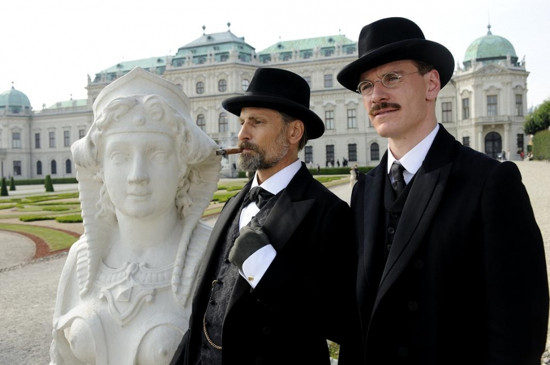The standard line on the difference between the respective psychological theories of Sigmund Freud and Carl Jung is that the former was unable to get past his obsessive insistence that everything is reducible to libidinal impulses (probably, as Vincent Cassel’s louche Otto Gross suggests here, because his own were left unfulfilled), while his younger apprentice developed a more nuanced, balanced approach to the unconscious.
What is made abundantly clear in this new film by David Cronenburg is that, on the contrary, it is Jung who is blinded by his blinkered Swiss Protestantism and willing to reach out to any form of pathetic mysticism, in avoiding acceptance of the self-evident sexual instincts plaguing him from all sides. The leitmotiv of Jung’s cloistered repression is the ever-yearning, never-resolving refrain from Wagner’s ‘Siegfried Idyll’, which seems to haunt him like an unacknowledged childhood trauma.
The time may finally be ripe for a film about the story of psychoanalysis. Aside from comedy cameos like that in Bill & Ted’s Excellent Adventure ("You may call me Siggy!"), you have to go back to Montgomery Clift in 1962 to find a portrait of Freud in mainstream American cinema. Clift gives us a much younger Freud than the surprisingly entertaining Viggo Mortensen does here, in a film by John Huston whose first draft was written by none other than Jean-Paul Sartre. But over the last decade, psychoanalysis has become once more the screen’s explicit content rather than its underlying, unspoken support.
In 2002, Adam Curtis’s award-winning documentary The Century Of The Self traced the influence of Freud’s ideas on his nephew Edward Bernays’ invention of public relations. Around the same time, former gag writer for hire, Matthew Weiner, wrote a spec script for what would become a hugely popular TV series set in the world of advertising in the early 1960s. Mad Men is a show which repeatedly asks, "What do women want?", echoing Freud. Meanwhile, Christopher Hampton wrote his play, The Talking Cure, upon which the present film has been based.
There is little about A Dangerous Method to remind you that you are watching a David Cronenberg film. There are none of his trademark visual perversions; perhaps because perversion has become here his subject, it is barred from utility as method. But this does not bother its director, who claims he never thinks of his previous films when working on a new picture. "They’re irrelevant," he insists. He needs simply ask of the script, following Mad Men, following Freud himself: "What does the film want?" The work then becomes his very own analysand.
"I’m evolving an austerity," Cronenberg noted of his recent output at a press conference at last year’s London Film Festival. But if A Dangerous Method lacks the sometimes gruesome bodily excess that characterised his work from Shivers to Crash, this is compensated for with an attention to minutiae. "Is it gaslight? Is it electric light? How will it reflect off that particular fabric?" he tarries. What was it Freud said about children who experience conflicts during the anal stage of their childhood sexual development?
Cronenberg’s very first film, a seven-minute short called Transfer, was a two-hander for a psychiatrist and his patient. In 1979’s The Brood, Oliver Reed played a shrink experimenting with ‘psychoplasmics’, the author of a book entitled The Shape Of Rage. But the director has stated it is rare for him to think consciously about psychoanalytic technique or concepts when developing a film, while admitting that, "for an artist growing up in crucible of the twentieth century", some form of Freudian influence is inescapable, "automatic". Ultimately, he avers, "art and psychoanalysis do the same thing – dive under the surface of reality".
And yet, ironically, A Dangerous Method operates to a very large degree on precisely such an unpierced surface. All four LFF press conference participants (Cronenberg, Hampton plus actors Mortensen and Michael Fassbender) commented on how very many words there are in this script – it was once known as The Talking Cure, after all. "I treated it as a piece of music," claimed Fassbender of his dialogue, and like Wagner’s counterpoint, it is a case of endless melody. Hampton’s characters are the very opposite of those you might find in a film by Bruno Dumont, who act but talk little.
In the end, what does all this talking cure? When the most dramatic moments in the film consist of people sat reading letters, one is tempted to suggest that it is the talking itself that requires curing, like an obstinate case of verbal diarrhoea. Sat in my cinema seat, I couldn’t help feeling that this story could have been just as well told by a well-edited and carefully annotated edition of the collected correspondence of its three protagonists.
Cronenberg’s newfound ‘austerity’ (a curious analogue to our financially straitened times) may be ‘evolved’ but it is the advanced evolution of a repressive desublimation. Today, the problem is not that people do not talk about their urges and their desires: they do so readily, at every opportunity, broadcasting their id to anyone who is not too busy shouting out their own peccadilloes to stop and listen. But amidst all this unceasing confession, there is little room for action.


